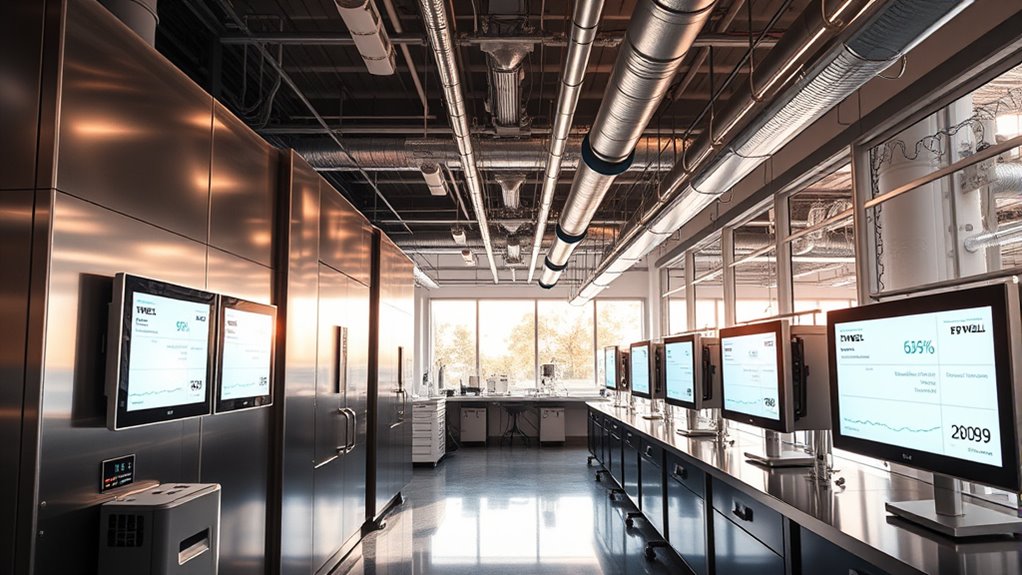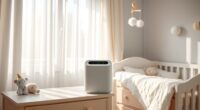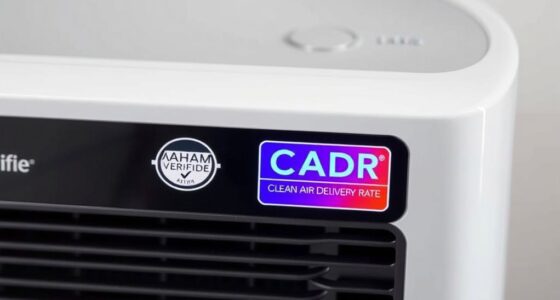Beyond LEED and WELL, you’ll find specialized air certification programs tailored for aviation and indoor environments. These programs focus on improving air quality through advanced filtration, continuous monitoring, and adherence to rigorous standards. They often address airborne pathogens, VOCs, and dust, promoting healthier spaces for passengers and staff. Exploring these options can help you implement cutting-edge solutions and stay ahead in environmental health standards—if you continue, you’ll discover more about these innovative certifications.
Key Takeaways
- Certification programs like RESET and BREEAM focus on rigorous indoor air quality testing and ongoing monitoring strategies.
- Some standards emphasize pathogen control and air filtration efficacy tailored for high-traffic or sensitive environments.
- International programs such as Green Globes and WELL Building Standard offer alternative frameworks with specific air quality benchmarks.
- Emerging certifications incorporate advanced technologies like real-time air quality sensors and data analytics for continuous improvements.
- Sector-specific standards, including aviation-focused certifications, address unique challenges in maintaining optimal indoor air environments.

Air certification programs are vital for guaranteeing safety, quality, and compliance within the aviation industry. While many are familiar with building certification standards like LEED and WELL, there are programs tailored specifically to address the unique demands of air quality and safety in various environments, including airports, aircraft, and indoor spaces. These programs emphasize indoor air quality, which is essential for passenger comfort, crew health, and operational safety. When you look beyond LEED and WELL, you’ll find certification standards designed to set rigorous benchmarks for air purity, filtration, ventilation, and overall environmental health.
In the context of aviation, indoor air quality isn’t just about comfort; it’s about safeguarding health. Certification standards focus on minimizing pollutants, controlling humidity, and reducing airborne pathogens. For example, specialized programs evaluate the effectiveness of filtration systems, ensuring that airborne contaminants like dust, VOCs, and bacteria are kept at bay. These standards often require continuous monitoring and regular maintenance, making sure that indoor air remains within safe and healthy parameters. When airlines and airport authorities adopt such standards, they demonstrate a commitment to providing a safer environment for everyone onboard or within the terminal.
Indoor air quality standards in aviation safeguard health by controlling pollutants and pathogens through continuous monitoring and maintenance.
You’ll also notice that certification standards are becoming more detailed, reflecting advances in air quality science and technology. They often specify minimum ventilation rates, air exchange efficiency, and the use of low-emission building materials. This focus guarantees that indoor air quality isn’t compromised by outdated systems or substandard materials. Additionally, technological innovations are increasingly integrated into certification criteria to enhance air purification and monitoring capabilities. For you, as someone involved in airport management, airline operations, or building design, understanding these standards helps you make informed choices about implementing the latest air quality measures. Certification programs not only promote healthier indoor environments but also enhance reputation, attract discerning travelers, and reduce liability risks tied to poor air quality.
Moreover, these standards are frequently aligned with international best practices and evolving regulations, ensuring consistency across different jurisdictions. Certification programs may also incorporate testing protocols, performance metrics, and certification renewal processes, which help maintain high standards over time. By adhering to these standards, you guarantee that your indoor spaces meet or exceed regulatory requirements, fostering a safer, healthier environment for all users. Ultimately, exploring these certification programs beyond LEED and WELL allows you to adopt specialized, science-backed strategies that profoundly improve indoor air quality—vital for passenger safety, staff well-being, and operational excellence.
Frequently Asked Questions
How Do Air Certification Programs Impact Overall Building Sustainability?
Air certification programs greatly impact overall building sustainability by prioritizing indoor air quality. They guarantee that indoor air is clean, reducing health risks and enhancing occupant comfort. The certification impact encourages building owners to adopt better ventilation, filtration, and sustainable materials. This not only improves indoor air but also supports energy efficiency and environmental goals, making your building more sustainable and healthier for everyone inside.
What Industries Benefit Most From Specialized Air Certification Programs?
You’ll find industries like healthcare, education, and hospitality benefit most from specialized air certification programs. These sectors prioritize indoor air quality to protect occupants and meet strict Certification standards. By adopting these programs, you guarantee healthier environments, reduce airborne contaminants, and demonstrate commitment to sustainability. Enhanced indoor air quality not only boosts occupant well-being but also strengthens your reputation for maintaining high standards in indoor environmental management.
Are There Regional Differences in the Adoption of Air Certification Standards?
You’ll find that regional disparities considerably influence air certification standards adoption, with some areas showing 40% higher adoption rates than others. Cultural influences, such as environmental awareness and regulatory priorities, shape these differences. In regions prioritizing health and sustainability, you’ll notice a quicker, more widespread embrace of specialized air certifications. Conversely, areas with less emphasis on environmental issues tend to lag, highlighting the importance of local context in certification uptake.
How Do Air Certification Programs Integrate With Existing Building Management Systems?
You can integrate air certification programs with your existing building management system by syncing indoor air quality sensors and ventilation controls. This allows real-time monitoring of indoor air and guarantees ventilation standards are maintained. By connecting these systems, you get automated alerts for any indoor air quality issues, enabling prompt action. It streamlines compliance with ventilation standards, improves indoor air quality, and helps your building earn certification points more efficiently.
What Are the Cost Considerations for Implementing Air Certification Requirements?
You should conduct a thorough cost analysis to understand the expenses involved in meeting air certification standards. Budget planning is essential, as costs can include new equipment, upgrades, and ongoing maintenance. Consider potential savings from improved indoor air quality and energy efficiency, which may offset initial investments. By carefully evaluating these factors, you can guarantee a sustainable approach to implementing air certification requirements without overspending or compromising project goals.
Conclusion
As you explore air certification programs beyond LEED and WELL, remember you’re like a pilot steering uncharted skies. Each new standard is a beacon guiding you toward healthier, more sustainable spaces. Just as a single gust of wind can shift a plane’s course, innovative air standards can transform your environment’s quality. Embrace these programs, and you’ll find yourself soaring above the rest, creating spaces that truly breathe with life and significance.










